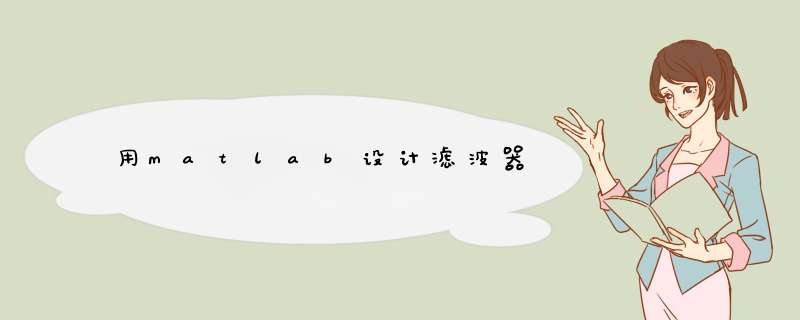
clearfs=2000t=(1:1000)/fs
x=10*cos(2*pi*30*t)+cos(2*pi*150*t)+5*cos(2*pi*600*t)
L=length(x)N=2^(nextpow2(L))Hw=fft(x,N)
figure(1)subplot(2,1,1)plot(t,x)
grid ontitle('滤波前信号x')xlabel('时间/s')% 原始信号
subplot(2,1,2)plot((0:N-1)*fs/L,abs(Hw))% 查看信号频谱
grid ontitle('滤波前信号频谱图')xlabel('频率/Hz')ylabel('振幅|H(e^jw)|')
%% x_1=10*cos(2*pi*30*t)
Ap=1As=60% 定义通带及阻带衰减
dev=[(10^(Ap/20)-1)/(10^(Ap/20)+1),10^(-As/20)]% 计算偏移量
mags=[1,0]% 低通
fcuts=[60,100]% 边界频率
[N,Wn,beta,ftype]=kaiserord(fcuts,mags,dev,fs)% 估算FIR滤波器阶数
hh1=fir1(N,Wn,ftype,kaiser(N+1,beta))% FIR滤波器设计
x_1=filter(hh1,1,x)% 滤波
x_1(1:ceil(N/2))=[]% 群延时N/2,删除无用信号部分
L=length(x_1)N=2^(nextpow2(L))Hw_1=fft(x_1,N)
figure(2)subplot(2,1,1)plot(t(1:L),x_1)
grid ontitle('x_1=10*cos(2*pi*30*t)')xlabel('时间/s')
subplot(2,1,2)plot((0:N-1)*fs/L,abs(Hw_1))% 查看信号频谱
grid ontitle('滤波后信号x_1频谱图')xlabel('频率/Hz')ylabel('振幅|H(e^jw)|')
%% x_2=cos(2*pi*150*t)
Ap=1As=60% 定义通带及阻带衰减
dev=[10^(-As/20),(10^(Ap/20)-1)/(10^(Ap/20)+1),10^(-As/20)]% 计算偏移量
mags=[0,1,0]% 带通
fcuts=[80,120,180,220]% 边界频率
[N,Wn,beta,ftype]=kaiserord(fcuts,mags,dev,fs)% 估算FIR滤波器阶数
hh2=fir1(N,Wn,ftype,kaiser(N+1,beta))% FIR滤波器设计
x_2=filter(hh2,1,x)% 滤波
x_2(1:ceil(N/2))=[]% 群延时N/2,删除无用信号部分
L=length(x_2)N=2^(nextpow2(L))Hw_2=fft(x_2,N)
figure(3)subplot(2,1,1)plot(t(1:L),x_2)
grid ontitle('x_2=cos(2*pi*150*t)')xlabel('时间/s')
subplot(2,1,2)plot((0:N-1)*fs/L,abs(Hw_2))% 查看信号频谱
grid ontitle('滤波后信号x_2频谱图')xlabel('频率/Hz')ylabel('振幅|H(e^jw)|')
%% x_3=5*cos(2*pi*600*t)
Ap=1As=60% 定义通带及阻带衰减
dev=[10^(-As/20),(10^(Ap/20)-1)/(10^(Ap/20)+1)]% 计算偏移量
mags=[0,1]% 高通
fcuts=[500,550]% 边界频率
[N,Wn,beta,ftype]=kaiserord(fcuts,mags,dev,fs)% 估算FIR滤波器阶数
hh2=fir1(N,Wn,ftype,kaiser(N+1,beta))% FIR滤波器设计
x_3=filter(hh2,1,x)% 滤波
x_3(1:ceil(N/2))=[]% 群延时N/2,删除无用信号部分
L=length(x_3)N=2^(nextpow2(L))Hw_3=fft(x_3,N)
figure(4)subplot(2,1,1)plot(t(1:L),x_3)
grid ontitle('x_3=5*cos(2*pi*600*t)')xlabel('时间/s')
subplot(2,1,2)plot((0:N-1)*fs/L,abs(Hw_3))% 查看信号频谱
grid ontitle('滤波后信号x_3频谱图')xlabel('频率/Hz')ylabel('振幅|H(e^jw)|')
你自己整合吧,我没时间帮你整合,我给你提供一些程序:绝对正确的代码:程序1:
fs=22050 %语音信号采样频率为22050
x1=wavread('Windows Critical Stop.wav')%读取语音信号的数据,赋给变量x1
sound(x1,22050) %播放语音信号
y1=fft(x1,1024) %对信号做1024点FFT变换
f=fs*(0:511)/1024
figure(1)
plot(x1) %做原始语音信号的时域图形
title('原始语音信号')
xlabel('time n')
ylabel('fuzhi n')
figure(2)
freqz(x1) %绘制原始语音信号的频率响应图
title('频率响应图')
figure(3)
subplot(2,1,1)
plot(abs(y1(1:512))) %做原始语音信号的FFT频谱图
title('原始语音信号FFT频谱')
subplot(2,1,2)
plot(f,abs(y1(1:512)))
title('原始语音信号频谱')
xlabel('Hz')
ylabel('fuzhi')
程序2:
fs=22050 %语音信号采样频率为22050
x1=wavread('Windows Critical Stop.wav')%读取语音信号的数据,赋给变量x1
t=0:1/22050:(size(x1)-1)/22050
y1=fft(x1,1024) %对信号做1024点FFT变换
f=fs*(0:511)/1024
x2=randn(1,length(x1)) %产生一与x长度一致的随机信号
sound(x2,22050)
figure(1)
plot(x2) %做原始语音信号的时域图形
title('高斯随机噪声')
xlabel('time n')
ylabel('fuzhi n')
randn('state',0)
m=randn(size(x1))
x2=0.1*m+x1
sound(x2,22050)%播放加噪声后的语音信号
y2=fft(x2,1024)
figure(2)
plot(t,x2)
title('加噪后的语音信号')
xlabel('time n')
ylabel('fuzhi n')
figure(3)
subplot(2,1,1)
plot(f,abs(y2(1:512)))
title('原始语音信号频谱')
xlabel('Hz')
ylabel('fuzhi')
subplot(2,1,2)
plot(f,abs(y2(1:512)))
title('加噪后的语音信号频谱')
xlabel('Hz')
ylabel('fuzhi')
根据以上代码,你可以修改下面有错误的代码
程序3:双线性变换法设计Butterworth滤波器
fs=22050
x1=wavread('h:\课程设计2\shuzi.wav')
t=0:1/22050:(size(x1)-1)/22050
Au=0.03
d=[Au*cos(2*pi*5000*t)]'
x2=x1+d
wp=0.25*pi
ws=0.3*pi
Rp=1
Rs=15
Fs=22050
Ts=1/Fs
wp1=2/Ts*tan(wp/2)%将模拟指标转换成数字指标
ws1=2/Ts*tan(ws/2)
[N,Wn]=buttord(wp1,ws1,Rp,Rs,'s') %选择滤波器的最小阶数
[Z,P,K]=buttap(N) %创建butterworth模拟滤波器
[Bap,Aap]=zp2tf(Z,P,K)
[b,a]=lp2lp(Bap,Aap,Wn)
[bz,az]=bilinear(b,a,Fs) %用双线性变换法实现模拟滤波器到数字滤波器的转换
[H,W]=freqz(bz,az)%绘制频率响应曲线
figure(1)
plot(W*Fs/(2*pi),abs(H))
grid
xlabel('频率/Hz')
ylabel('频率响应幅度')
title('Butterworth')
f1=filter(bz,az,x2)
figure(2)
subplot(2,1,1)
plot(t,x2) %画出滤波前的时域图
title('滤波前的时域波形')
subplot(2,1,2)
plot(t,f1)%画出滤波后的时域图
title('滤波后的时域波形')
sound(f1,22050) %播放滤波后的信号
F0=fft(f1,1024)
f=fs*(0:511)/1024
figure(3)
y2=fft(x2,1024)
subplot(2,1,1)
plot(f,abs(y2(1:512)))%画出滤波前的频谱图
title('滤波前的频谱')
xlabel('Hz')
ylabel('fuzhi')
subplot(2,1,2)
F1=plot(f,abs(F0(1:512))) %画出滤波后的频谱图
title('滤波后的频谱')
xlabel('Hz')
ylabel('fuzhi')
程序4:窗函数法设计滤波器:
fs=22050
x1=wavread('h:\课程设计2\shuzi.wav')
t=0:1/22050:(size(x1)-1)/22050
Au=0.03
d=[Au*cos(2*pi*5000*t)]'
x2=x1+d
wp=0.25*pi
ws=0.3*pi
wdelta=ws-wp
N=ceil(6.6*pi/wdelta) %取整
wn=(0.2+0.3)*pi/2
b=fir1(N,wn/pi,hamming(N+1)) %选择窗函数,并归一化截止频率
figure(1)
freqz(b,1,512)
f2=filter(bz,az,x2)
figure(2)
subplot(2,1,1)
plot(t,x2)
title('滤波前的时域波形')
subplot(2,1,2)
plot(t,f2)
title('滤波后的时域波形')
sound(f2,22050) %播放滤波后的语音信号
F0=fft(f2,1024)
f=fs*(0:511)/1024
figure(3)
y2=fft(x2,1024)
subplot(2,1,1)
plot(f,abs(y2(1:512)))
title('滤波前的频谱')
xlabel('Hz')
ylabel('fuzhi')
subplot(2,1,2)
F2=plot(f,abs(F0(1:512)))
title('滤波后的频谱')
xlabel('Hz')
ylabel('fuzhi')
h = freqs(b, a, w) 根据系数向量计算返回滤波器的复频域响应。调用这个低通滤波器时,使用下面的函数
sf=filter(a,b,s)%s为需滤波的数据,sf经过你设计的低通滤波器以后的新数据
欢迎分享,转载请注明来源:内存溢出

 微信扫一扫
微信扫一扫
 支付宝扫一扫
支付宝扫一扫
评论列表(0条)